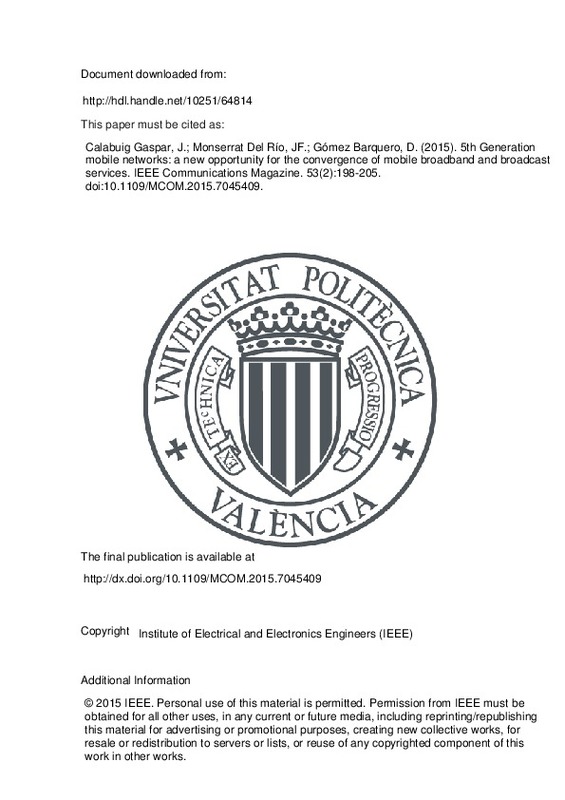JavaScript is disabled for your browser. Some features of this site may not work without it.
Buscar en RiuNet
Listar
Mi cuenta
Estadísticas
Ayuda RiuNet
Admin. UPV
5th Generation mobile networks: a new opportunity for the convergence of mobile broadband and broadcast services
Mostrar el registro sencillo del ítem
Ficheros en el ítem
| dc.contributor.author | Calabuig Gaspar, Jordi
|
es_ES |
| dc.contributor.author | Monserrat del Río, José Francisco
|
es_ES |
| dc.contributor.author | Gómez Barquero, David
|
es_ES |
| dc.date.accessioned | 2016-05-26T13:55:24Z | |
| dc.date.available | 2016-05-26T13:55:24Z | |
| dc.date.issued | 2015-02 | |
| dc.identifier.issn | 0163-6804 | |
| dc.identifier.uri | http://hdl.handle.net/10251/64814 | |
| dc.description | © 2015 IEEE. Personal use of this material is permitted. Permission from IEEE must be obtained for all other uses, in any current or future media, including reprinting/republishing this material for advertising or promotional purposes, creating new collective works, for resale or redistribution to servers or lists, or reuse of any copyrighted component of this work in other works. | es_ES |
| dc.description.abstract | [EN] This article analyzes the challenges and opportunities that the upcoming definition of future 5G mobile networks brings to the mobile broadband and broadcast industries to form a single converged network. It reviews the state-of-the-art in mobile and broadcast technologies and the current trends for convergence between both industries. This article describes the requirements and functionalities that the future 5G must address in order to make an efficient and flexible cellular-broadcasting convergence. Both industries would benefit from this convergence by exploiting synergies and enabling an optimum use of spectrum based on coordinated spectrum sharing. | es_ES |
| dc.description.sponsorship | The authors would like to thank the funding received from the Spanish Ministry of Science and Innovation within the Project number TEC2011-27723-C02-02. | |
| dc.language | Inglés | es_ES |
| dc.publisher | Institute of Electrical and Electronics Engineers (IEEE) | es_ES |
| dc.relation.ispartof | IEEE Communications Magazine | es_ES |
| dc.rights | Reserva de todos los derechos | es_ES |
| dc.subject | 5G mobile networks | es_ES |
| dc.subject | Mobile broadband | es_ES |
| dc.subject | Broadcast industries | es_ES |
| dc.subject | Cellular-broadcasting convergence | es_ES |
| dc.subject.classification | TEORIA DE LA SEÑAL Y COMUNICACIONES | es_ES |
| dc.title | 5th Generation mobile networks: a new opportunity for the convergence of mobile broadband and broadcast services | es_ES |
| dc.type | Artículo | es_ES |
| dc.identifier.doi | 10.1109/MCOM.2015.7045409 | |
| dc.relation.projectID | info:eu-repo/grantAgreement/MICINN//TEC2011-27723-C02-02/ES/COMUNICACIONES MOVILES COOPERATIVAS EFICIENTES MEDIANTE RELAYING Y MBMS AVANZADOS/ | es_ES |
| dc.rights.accessRights | Abierto | es_ES |
| dc.contributor.affiliation | Universitat Politècnica de València. Instituto Universitario de Telecomunicación y Aplicaciones Multimedia - Institut Universitari de Telecomunicacions i Aplicacions Multimèdia | es_ES |
| dc.contributor.affiliation | Universitat Politècnica de València. Departamento de Comunicaciones - Departament de Comunicacions | es_ES |
| dc.description.bibliographicCitation | Calabuig Gaspar, J.; Monserrat Del Río, JF.; Gómez Barquero, D. (2015). 5th Generation mobile networks: a new opportunity for the convergence of mobile broadband and broadcast services. IEEE Communications Magazine. 53(2):198-205. https://doi.org/10.1109/MCOM.2015.7045409 | es_ES |
| dc.description.accrualMethod | S | es_ES |
| dc.relation.publisherversion | http://dx.doi.org/10.1109/MCOM.2015.7045409 | es_ES |
| dc.description.upvformatpinicio | 198 | es_ES |
| dc.description.upvformatpfin | 205 | es_ES |
| dc.type.version | info:eu-repo/semantics/publishedVersion | es_ES |
| dc.description.volume | 53 | es_ES |
| dc.description.issue | 2 | es_ES |
| dc.relation.senia | 300622 | es_ES |
| dc.contributor.funder | Ministerio de Ciencia e Innovación |







![[Cerrado]](/themes/UPV/images/candado.png)

